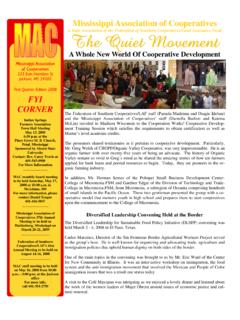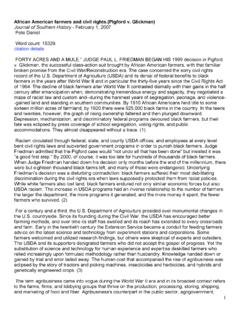Transcription of United States Agriculture Black Farmers in …
1 United StatesDepartment ofAgricultureRural Business CooperativeServiceRBS ResearchReport 194 Black Farmers inAmerica, 1865 - 2000 The Pursuit of IndependentFarming and the Role ofCooperativesAbstractBlack Farmers in america have had a long and arduous struggle to own land and tooperate independently. For more than a century after the Civil War, deficient civil rightsand various economic and social barriers were applied to maintaining a system wheremany blacks worked as farm operators with a limited and often total lack of opportunityto achieve ownership and operating independence. Diminished civil rights also limitedcollective action strategies, such as cooperatives and unions. Even so, various typesof cooperatives, including farmer associations, were organized in Black farming com-munities prior to the 1960s. During the 1960s, the civil rights movement brought a newemphasis on cooperatives. Leaders and organizations adopted an explicit purposeand role of Black cooperatives in pursuing independent farming.
2 Increasingly, newtechnology and integrated contracting systems are diminishing independent decision-making in the management of farms. As this trend expands, more cooperatives maybe motivated, with a determination similar to those serving Black Farmers , to pursueproactive strategies for maintaining independent idea of conducting this research was developed from reading an unpublishedmanuscript by a co-worker, Beverly Rotan, which was based on several case studiesof Black farmer cooperatives. Her research indicated that historical background wasessential to understanding many of the current conditions for Black Farmers and theircooperatives. Discussions with Beverly and another co-worker, Edgar Lewis, wereindispensable in the effort to adequately understand the goals and practices of blackfarmers and cooperatives. John Zippert of the Federation of SouthernCooperatives/Land Assistance Fund provided background on some of the major devel-opments of Black farmer cooperatives during the 1960s and 1970s, as well as provid-ing a substantial set of key documents.
3 The historical component of this report relied toa large extent on three excellent books by the Smithsonian Institution scholar, PeteDaniel (see the References section). Furthermore, he reviewed an earlier version. Hissuggestions were helpful for making several improvements in this report. A secondversion was reviewed by Professor Robert Zabawa of Tuskegee University andSpencer Wood, a doctoral candidate in sociology at the University of Wisconsin. Theyoffered several excellent critical observations and 2002 Reprinted October 2003 ContentsIntroduction ..1 Black Farmers in the South, 1865 -1932 ..2 Independent Farming Initiatives, 1886-1932 ..5 New Deal Agriculture ..8 The Civil Rights Movement and Cooperatives ..10 Promoting Independent Farm Enterprise Through Cooperatives ..13 Summary ..18 References ..19 Appendix Table 1- A Chronology, 1865 -1965 ..22 Appendix Table 2- Number of farm operators and operating status, 1900-1959.
4 23 Appendix Table 3- Farm operators in the by race, 1900-1997 ..24iBlack Farmers in america , 1865 - 2000 The Pursuit of Independent Farming and the Role ofCooperativesBruce J. ReynoldsEconomistRural Business-Cooperative ServiceFarming as a family-owned and independentbusiness has been an important part of the social andeconomic development of the United States . But formany Black Farmers it was more often than not a end of slavery was followed by about100 years of racial discrimination in the South that lim-ited, although it did not entirely prevent, opportunitiesfor Black Farmers to acquire of civil rights in the 1950s-60sremoved many overt discriminatory barriers, althoughby that time increased technology had significantlyreduced the demand for Farmers in agricultural pro-duction. Nevertheless, cooperatives, while havingsome limited application in earlier decades, emergedas a significant force for Black Farmers during the civilrights movement.
5 They assumed a major role in mar-keting and purchasing and in improving opportunitiesfor Black Farmers to retain their ownership of essentially helped keep alive a traditional aspira-tion for independent farming. This report reviews thehistory of Black Farmers to explore the role of coopera-tives in their pursuit of independent term "independent farmer" is often used fordifferent purposes, ranging from description of a per-sonality-type to justifications for farm policy. A gener-al definition is an individual who makes farm-operat-ing decisions that have variable risk and rewardoutcomes. For independent farming to be successful,risk/reward combinations must be competitive withwhat is offered by alternative production systems thatdiminish operating independence of 25 years ago, an independent farmer wasgenerally defined as having freedom to make decisionswith risk and reward consequences while functioningin an interdependent market system (Breimyer, 116-17;Lee, 40-43).
6 While this definition is still valid, interde-pendencies in the farm economy are increasing andfarm decision-making has become more coordinatedand restricted during the last 25 years (Wolf).Definitional boundaries of farming independenceare left to Farmers and agribusiness to negotiate with-out major interference by government in determininghow risk and reward are shared. In general, public pol-icy and agricultural research are focused on how toincrease aggregate income and to provide a farm safe-ty net, but for the most part are neutral about theextent of a farmer s entrepreneurial abolition of slavery did not end domineering systems ofcommand and control by some white planters over most blackfarm operators. The undermining of opportunity for blacks todevelop independent farming, in many cases by the use ofpeonage, existed well into the post-World War II era. (Daniel1972). agricultural policy in general has adhered slightly more to aphilosophy of "consumer sovereignty" in regard to not directlypromoting the operating independence of Farmers , than forexample, French agricultural policy.
7 For a comparison betweenFrench and policies on the role of cooperatives with respect toindependent farming of grapes for wine production, see Knox. Foran institutional and policy comparison between the andFrance regarding the relative importance of consumer sovereigntyand of human factors of production, , independent Farmers , leaves cooperatives, with their democraticcontrol of value-added businesses, as the major institu-tional mechanism for sustaining independent , as applied in predominantly white farmingregions of the , members operating independenceis assumed and the primary objective of cooperativesis to maximize member earnings. By itself, indepen-dent farming traditionally has been regarded as onlyan implicit objective in these many white Farmers , independent farminghas been an economically challenging vocation, butunlike Black Farmers , they have not experienced socialand institutional barriers to owning and operatingfarms.
8 For many Black Farmers , there is a special incen-tive to operate independently: to avoid both farmingunder the controlling systems that many whiteplanters applied in the past, and the trade credit prac-tices that led to foreclosure on land they owned(Litwack, 137).Since the civil rights movement, cooperativeshave played an important part in helping Black farm-ers to sustain or develop as independent operators. Asa public issue, the objectives have been civil rights andfighting poverty, and not independent farming. In fact,during President Lyndon Johnson s "war on poverty,"many of today s Black farmer cooperatives got theirstart with financial assistance from the FederalGovernment. But to Black Farmers and communityleaders, building and sustaining operating indepen-dence is a concomitant objective and cooperatives havea major role in achieving that experience of Black Farmers is directly con-nected with major events in Afro-American and gener-al history.
9 For a quick reference on pertinent his-torical developments, see a chronology of periods andevents for 1865 -1965 in Appendix Table 1. The first sec-tion of this report discusses farm-operating arrange-ments that developed during Reconstruction and thesubsequent decades of progress for some, but worsen-ing conditions for most Black Farmers with the rise ofthe Jim Crow era in the 1890s. The second sectionexamines development of three strategies during theperiod of 1880 to 1932 for establishing independentfarmers: cooperatives, farm settlement projects, andfarming self-sufficiency. The third section describes theimpact and legacy of the New Deal period, 1933-41, onthe prospects for Black Farmers . The fourth sectionexamines the influence of the civil rights movement onthe rise of Black farmer cooperatives during the 1950-60s and the role of the Federation of SouthernCooperatives/Land Assistance Fund (FSC/LAF). Thelast section discusses some of the challenges in usingcooperatives to sustain independent Black Farmers ,and how they are being met in rural Black communi-ties to accomplish value-added Farmers in the South, 1865 -1932 Abolitionists worked to end slavery for severaldecades before the Civil War, but most were uncon-cerned about how former slaves would transition tofreedom in a capitalist society (Pease, 19 and 162).
10 When victory by the North was imminent, this issuewas immediately in the forefront. Its resolutionrequired answering a basic question: to what extentshould government provide for a transition to "free"labor rather than support the desire of many freedmento be independent Farmers ?There were isolated opportunities for formerslaves to acquire land. As early as 1862, Union gener-als subdivided some plantations of Confederate lead-ers for small farm settlements by former slaves. Thegovernment sold confiscated land on St. Helena Islandand Port Royal, SC, in 1863 to a philanthropist-entre-preneur who produced cotton by hiring freedmen andarranged mortgage payment plans for those Farmers togradually purchase the land (Pease, 139-41).The first Freedmen s Bureau Act in 1865 includedplans for 40-acre tracts to be sold on easy terms fromeither abandoned plantations or to be developed onunsettled lands. But by late 1865 , President AndrewJohnson terminated further initiatives by the UnionArmy for small farm settlements.






